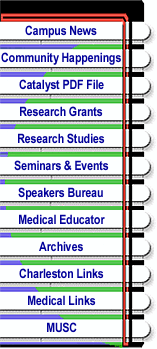
Return to Main Menu |
Project
examines nutrition in disease process
-
In human prehistory, members of the Cave Bear Clan were told by their
medicine woman to drink tea made from the elecampane root to cure the lung
disease of spitting blood.
-
In ancient Egypt a tea from the root of the pomegranate tree was used
to treat people for worms.
-
During the Middle Ages fennel was the plant of choice for weight loss.
-
From Shakespeare we learn that healers in the sixteenth century made
use of violets to treat inflammation of the liver.
-
And among the American Indians cornsilk was a component of the remedy
for urinary tract infections.
-
Every culture has instinctively known that plants—their seeds, roots,
stems, leaves, flowers—can cure.
-
Today’s researchers investigate traditional herbal and vegetal cures
from a variety of cultures and re-evaluate the fruits and vegetables which
21st century Americans consume.
by Ann Lacy
Special to The Catalyst
At MUSC Thomas Walle, Ph.D., studies the effects of normal dietary
constituents on epithelial malignancies of the mouth, the esophagus, the
lungs, and the colon.
 Dr.
Thomas Walle Dr.
Thomas Walle
“Our main interest in the lab is focused on whether dietary flavonoids,
present in our daily food, can enter the human body and produce beneficial
biological effects, in particular in cancer,” said Walle, a professor in
the Department of Cell and Molecular Pharmacology and Experimental Therapeutics.
Flavonoids are a large family of micronutrients present in common fruits
and vegetables. There are more than 5,000 flavonoids in the plant
kingdom. They possess antioxidant and antibacterial qualities and
provide coloring in plants. Recent studies have shown that flavonoids
have potent effects on many pathways associated with tumor development
and growth.
In one of his projects Walle is exploring the effects of certain food
components on cancer of the oral cavity. Flavonoids are present in
large quantities in certain common foods and drinks, including apples,
onions, tea, and red wine. However, most of them are present in the
food or drink as conjugates with glucose which are inactive in their natural
state.
A novel finding in Walle’s lab is that human saliva can convert the
conjugate and release the active flavonoid. Quercetin is one of the flavonoids
upon which Walle’s cancer studies are focused. Quercetin forms in the oral
cavity where it acts directly on the mouth’s epithelial cells.
“To test the potential importance of this finding, we treated oral
squamous cell carcinoma cells with quercetin and measured its effect on
cell proliferation. Quercetin produced a dramatic inhibition of the number
of metabolically competent cells with a significant reduction occurring
at the very low concentration.”
He goes on to point out that “such low quercetin concentrations may
easily be achieved in the oral cavity by eating an apple.” An apple, in
fact, is one of the richest sources of this dietary flavonoid.
Quercetin has several cancer-preventive roles. As Walle explains,
“In this case we are not trying to prevent carcinogens from binding to
DNA, which is one mode of action of quercetin, but rather to stop tumor
cells at their very early development from growing.”
These multiple aspects of Walle’s research are being supported by a
major R01 grant from the National Institutes of Health for the next four
years as well as by grants from the U.S. Department of Agriculture, the
School of Public Health of Ohio State University, the American Institute
of Cancer Research, and the Department of Defense through the Hollings
Cancer Center.
In addition, Walle’s lab is doing a clinical study in conjunction with
the General Clinical Research Center (GCRC) with oral and intravenous administration
of resveratrol, a flavonoid-like polyphenol with promising anticancer effects
in cells. Working with Mark Delegge, M.D., from the Digestive Disease
Center, Walle has established preliminary results in a number of healthy
human subjects.
“We don’t know what happens to these dietary flavonoids in the human
body.” Thus, the lab results must be tested in vivo.
In the planning stage is a third component to Walle’s research. He
will work with faculty and students in the College of Dental Medicine to
determine which factors in human saliva help convert the dietary flavonoids
into quercetin.
Walle has a lab crew of a research associate, a lab technician, and
four graduate students who all work on different aspects of these projects.
Walle and his staff are engaged in solving one of the most compelling problems
in twenty-first century medicine: cancer.
Yet Walle is at the same time working in a tradition that dates back
millennia. Like the healers of the ancient world, he is “taking advantage
of normal dietary constituents” with twenty-first century understanding
and techniques to influence the disease process.
Catalyst Online is published weekly, updated as
needed and improved from time to time by the MUSC Office of Public Relations
for the faculty, employees and students of the Medical University of South
Carolina. Catalyst Online editor, Kim Draughn, can be reached at 792-4107
or by email, catalyst@musc.edu. Editorial copy can be submitted to Catalyst
Online and to The Catalyst in print by fax, 792-6723, or by email to petersnd@musc.edu
or catalyst@musc.edu. To place an ad in The Catalyst hardcopy, call Community
Press at 849-1778.
|



 Dr.
Thomas Walle
Dr.
Thomas Walle